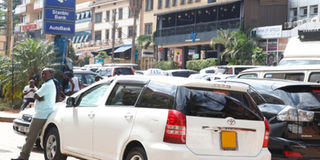How profitable is Uganda’s special hire taxi business?

A special hire taxi in Kampala. Several special hire taxi companies are struggling to gain a fair share of the market in Uganda’s transport sector. PHOTO BY RACHEL MABALA
A few years ago, one would have to go to a taxi stage to find a special hire taxi if they needed one. If you were lucky to have their contacts, you would then call one and if he was far, then you would wait until they returned.
All this changed last year when Uber, an online taxi service launched in Uganda taking the industry by surprise and changing urban mobility. But before this, there was entry of some private car hire businesses into the industry.
According to Blu Cruise proprietor, a car hire company, Ms Stephen Ochola this was not only because more companies are outsourcing their transport need but the way car hire business is being done compared to the previous way, of special hires.
“It is more of organised groups. People think it is a viable business. Apps have helped to overcome many transport challenges so this has cut down on the bottlenecks of doing business,” he says.
Rise of Uber
Kampala was the 462nd city that Uber launched. Two things were distinct. The first being you could order for a taxi online and watch it arrive. The second was you could track your journey home on the app. For taxi drivers, this meant a new market place created from the urban folk. It was also a time for drivers to make a killing, driving people in the thick Kampala traffic, and in the night from bars and clubs across town.
Uber is a service that uses technology to empower any owner of a vehicle to take part in commercial ride-sharing ventures. It has revolutionised the transport industry in many European and US cities and created jobs, as one simply needs a car and a smartphone to register. Customers can easily order the service via a smartphone app. Therefore, in many places, it has provided cheaper and more reliable transport than the traditional taxis.
Mr Moses Mulindwa, an Uber driver, says he never quit his job to be a driver but looked out for a venture that was worth undertaking.
“This is more like working smart.
I have a platform where I can get my clients without having to negotiate and I do not have ties with anyone, I can work when I want. If I want to work, I go online,” he says.
Like some businesspeople, Mr Mulindwa took out a loan from three people to buy a car that he currently uses to transport clients.
When he had just started working using Uber in September, there were free incentives on the platform, the money was great because he would get Shs10,000 per hour for remaining online and nearly Shs10,000 per trip taken. He claims drivers were making millions of shillings in a week.
However this changed when the firm slashed prices to attract new clientele. Last year, a trip cost Shs900 per kilometre minus the incentives, Shs200 per minute and base fare of Shs1,300. A trip from Acacia Mall to Najjera was between Shs13,000 and Shs15,000 for a 10-minute journey. Unfortunately, the rates were cut to Shs750 per kilometre, Shs150 per minute and base fare to Shs1,100 to attract a bigger market.
Lower rates
“A trip that used to be Shs15,000 is now Shs10,000 so it means on every trip I take, I am losing about Sh5,000. In the long-run, if I do 10 trips, I lose about Shs50,000. If they had kept that fare, we would get by,” he says.
Mr Mulindwa says the business has become tough because of the high costs of fuel spent yet the returns are limited by the low rates, high cost of servicing a car.
“I service the car after every three weeks because I will drive 500km every weekend which is from Friday, Saturday and Sunday and this costs me Shs75,000 to 95,000 depending on what exactly I have to change.”
Amidst these challenges, Mr Mulindwa is worrisome on whether he will be able to pay back his loan.
“The rate at which am going, I might have to sell the car so I can pay it off,” he says.
On an average day, depending on the opportunities and minimal traffic jam, he makes 10 to 15 trips that get him a profit of Shs70,000. On a bad day, he says he will start the day with Shs50,000 and return home with Shs40,000, because the amount of money he pays for fuel is not equivalent to what clients pay.
He, however, says the business is profitable because people need a service especially those who work at night.
The only problem is it is not viable for the drivers.
“At the end of the day, I am going to quit because I cannot make money using this. If at most I am making Shs300,000 a week, this is peanuts in the transport business,” he says.
This has given the online taxi hailing applications a bad image especially for Ugandan start-ups that have joined the craze and developed similar platforms.
Mr Latimer Wandera, general manager Spesho Uganda LTD, a start-up that offers practical transport solutions with reasonably priced rides available both day and night, says many drivers have been demoralised by the price cuts. He says many of them think they are all the same yet their service offerings are different.
Spesho launched in March 2017 and has signed up more than 100 drivers on its platform. However, unlike Uber, the company offers three product offerings, on demand cab hailing hiring, scheduled trips, and virtual driver where one can just hire a driver for a day.
Spesho offers location based cab hailing services.
Technically, as long as there’s an Internet/data connection, you can request for the service. But at the moment, Spesho’s driver network is limited to Kampala and the greater Kampala area which is commonly referred to as a Request area.
Uber has sparked controversy in many cities due to concerns of regulation as and how the service can be taxed. The potential costs in this respect for cities such as Kampala where it is not easy to identify an Uber taxi or even a special hire unless one is identified by the app.
Services like Uber could provide mechanisms for user-based self-regulation in areas of pricing and safety.
Challenges
Operation costs are high because the price of fuel is very high, yet on a daily basis, Mr Ochola says one has to fuel the car, pay allowances to drivers and do car repairs.
“I cannot put a cost because the operational costs vary a lot. But you are looking at maybe a total of up to about 30 to 40 per cent of your earnings,” he says.
Besides, the road network greatly increases costs.
“A car works for a maximum of one and a half years and then we have to put it off our fleet because it is mechanically unsound and its purely because of our roads,” Mr Ochola says.
No Regulation in Uganda
Mr Winstone Katushabe, the commissioner transport regulation and safety at the ministry of Works and Transport, says they are in the process of regulating special hire taxi operations. He says they learnt about the online taxi system when Uber entered the Ugandan market in 2016.
He says these are new developments in terms of regulatory frameworks for the country. But under the current law, there is no provision for vehicles or business of such nature online where you can have an app, you choose a driver and they come to you.
“Government is in the final stages of drafting rules and regulations to govern these special hire taxi services,” he says.
The entry of online taxi hire services has allowed many different individuals to use their cars for special hire taxi services leaving a huge regulation gap.
Mr Katushabe says a passenger can be murdered in a vehicle and nobody takes charge. What we have done is come up with new amendments to the law. He says it is one of the proposals, already before cabinet for consideration.
The new amendments will require the online taxi hire services to provide the ministry with a profile of their drivers.
“We have asked Uber to submit all the drivers they have on the platform for biometrics inspection. Additionally, they will be investigated by Interpol so that in case of anything, we are able to trace that driver,” he says.
He says they intend to confirm that the people who are operating these vehicles are the rightful owners and all vehicles have to be verified by Uganda Revenue Authority to get them on to the database.
Taxes
Once you leave Uber unregulated, there are a number of negative impacts to society including taxation, security and safety. The ministry is working to ensure they comply with all the regulatory regimes of the country.
In terms of safety, lax or lacking regulation means any person can operate a taxi, regardless of the state of their vehicle or whether they have a valid driving licence.
Accreditation of drivers
The ministry has also asked them for a list of these drivers so that they carry out further checks on their conduct, professionalism and competence of the driving permits they have.
“If a driver wants to do Uber and you ask him:do you have a card by ministry of works and transport, if they don’t have, there is reason for suspicion. Special hire vehicles must be marked and that is the only way you can quickly tell. Currently, they are working but illegally,” he says.
Revenue sharing
For a base rate of Shs1,100, Shs750 per km, and Shs150 per minute charge, Uber recently revised its prices to attract more people to use the online taxi services. This is affordable compared to what one would pay previously using the old taxis
The drivers are expected to remit between 25 to 30 per cent of the fares per trip to the online apps. Uber calculates how much the driver is supposed to receive and how much they are supposed to remint.
How online apps work
According to Mr Latimer Wandera, general manager Spesho Uganda LTD, to use the online apps, one has to download the app on to their smartphone. Spesho currently allows downloads from Google play store for Android enabled phones. Uber, on the other hand, can be downloaded both from Google play store and App store for android and IOS enabled phones, respectively.
After downloading the app, you can either sign up as a driver or rider. For those using the uber app, open the app. Then request for a ride by tapping each ride option to see wait time, size and price. Then enter your pickup location and tap request—your driver will arrive in minutes. The car will come to you. You’ll see your driver’s contact information and vehicle details in the app, so you know you’re getting in the right car. When you reach your destination, pay and go. The app also allows you to rate your driver when you reach your destination.




